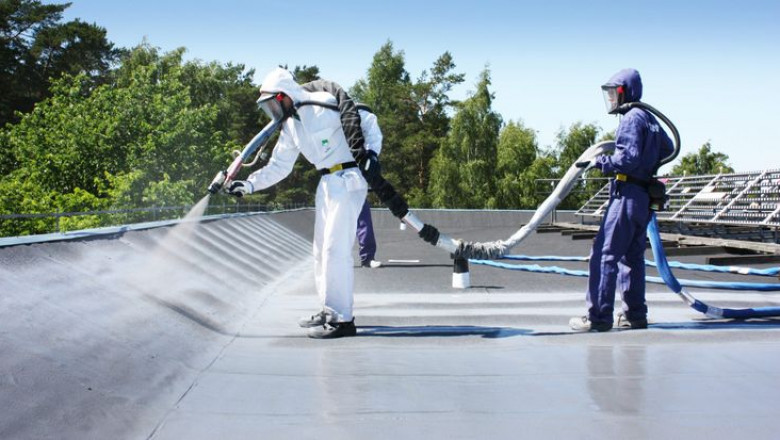views
Polyurea
Polyurea is a spray-applied elastomeric coating formed by the reaction of an isocyanate component and a resin blend component. This chemical reaction occurs rapidly at the spray gun in the presence of moisture, forming a monolithic, seamless membrane that adheres to the properly prepared substrate. Polyurea coatings were developed in the late 1980s and have grown significantly in popularity due to their superior physical properties compared to other protective coating types.
Chemical composition
At its most basic, Polyurea Coatings results from exposing an isocyanate to an amine-terminated polymer resin. The isocyanate used is typically a monomer such as methylene diphenyl diisocyanate (MDI) or toluene diisocyanate (TDI). The resin is generally a polyamine-terminated polyether or polyester blend. When applied via plural-component spray equipment, the isocyanate and resin blend react, joining through urethane linkages to form the elastomeric polyurea membrane. This reaction occurs extremely rapidly at ambient temperatures.
Physical properties
The unique chemistry of polyurea translates to outstanding physical properties that make it well-suited for demanding protective coating applications. Some key attributes include:
- Tensile strength: Polyurea typically has tensile strength over 3000 psi, enabling it to stretch to over 500% of its original length. This extreme flexibility and elongation allow it to bridge gaps and expand/contract with the substrate.
- Abrasion resistance: The elastomeric nature of polyurea results in excellent abrasion resistance, with the coating able to withstand erosion up to 10 times better than traditional coatings.
- Chemical resistance: Being a fully-reacted, closed-cell membrane, polyurea is highly resistant to corrosion and provides long-term protection against acids, alkalis, solvents, and other chemicals.
- Permeability: Due to its compression and elongation properties, polyurea creates an impermeable water/vapor barrier with very low permeability to protect against moisture intrusion.
Common applications
Given its outstanding protective qualities, polyurea coatings has found wide use in several industries for durable coating applications:
Infrastructure protection
- Bridge deck coating: Polyurea extends the life of concrete bridge decks by forming a seamless membrane over the surface that is highly abrasion resistant.
- Water/waste water containment: Used to reline or construct new sewage containers, manholes, and tanks by providing a chemical-resistant barrier.
Industrial containment
- Tank lining: Applied to line the interior of storage tanks for hazardous liquids or chemically aggressive materials.
- Secondary containment: Spray-applied to form new containment areas or seamlessly line existing areas.
Transportation
- Truck bed liners: Provides a non-slip surface and protects cargo areas from wear and chemicals.
- Aircraft hangar flooring: Used for its flexibility and ability to withstand heavy traffic abrasion.
polyurea coatings have emerged as an important technology for protecting assets and infrastructure in a variety of industries. Forming an impermeable, highly elastic, and chemically resistant membrane, polyurea extends the lifespan of substrates and preserves structural integrity. Its rapid-cure application also translates to cost savings through reduced downtime. As the benefits of polyurea continue to be recognized, its use in protective coating solutions will likely expand further.
Discover the Report for More Insights, Tailored to Your Language:
About Author:
Priya Pandey is a dynamic and passionate editor with over three years of expertise in content editing and proofreading. Holding a bachelor's degree in biotechnology, Priya has a knack for making the content engaging. Her diverse portfolio includes editing documents across different industries, including food and beverages, information and technology, healthcare, chemical and materials, etc. Priya's meticulous attention to detail and commitment to excellence make her an invaluable asset in the world of content creation and refinement.
(LinkedIn- https://www.linkedin.com/in/priya-pandey-8417a8173/)






















Comments
0 comment